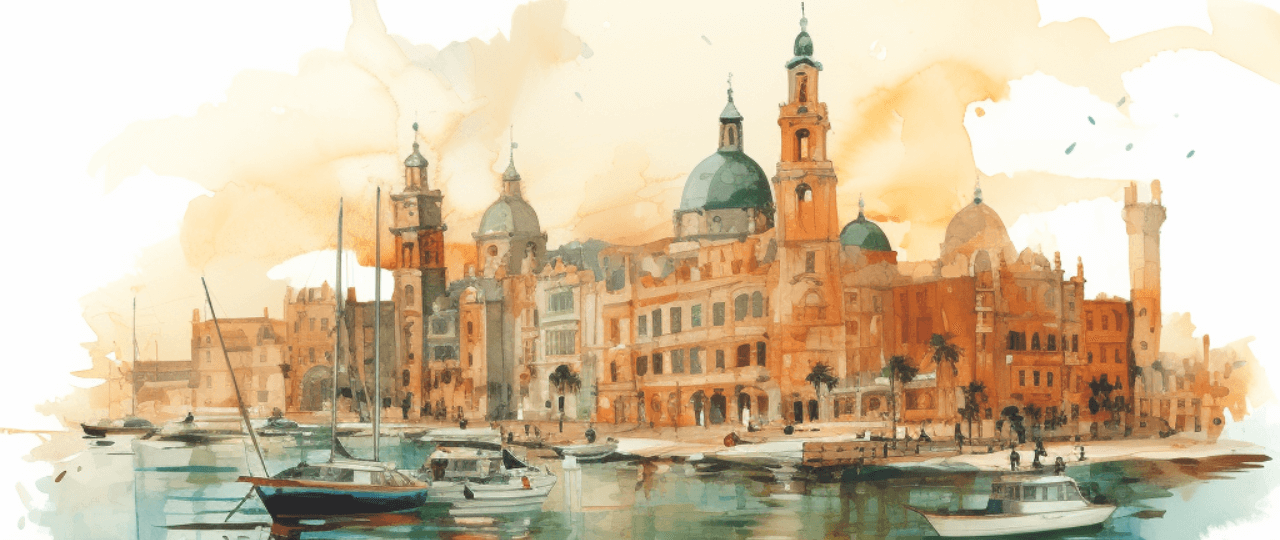Brief overview of Alexandria
Alexandria is located on the Mediterranean coast of Egypt, is a city steeped in history and rich in cultural experiences. Founded by Alexander the Great in 331 BCE, it became a center of Hellenistic civilization and was famed for its lighthouse, one of the Seven Wonders of the Ancient World, and its library, the most significant library of the ancient world. Although these iconic landmarks have not survived to the present day, Alexandria remains a vibrant city that holds a unique mix of history and modernity.
Today, the city is the second-largest in Egypt and a major economic hub due to its port, the largest in the country. It’s a popular tourist destination offering a range of attractions from historical sites, such as the Citadel of Qaitbay and Pompey’s Pillar, to modern attractions like the stunning Bibliotheca Alexandrina. The city’s Mediterranean charm, seafront corniche, diverse heritage, and cosmopolitan atmosphere make it a must-visit destination for those exploring Egypt.
Best Time to Visit
The ideal time to visit Alexandria is during the spring (March to May) and autumn (September to November) months. During these periods, the weather is pleasantly warm with less humidity, and there are fewer tourists.
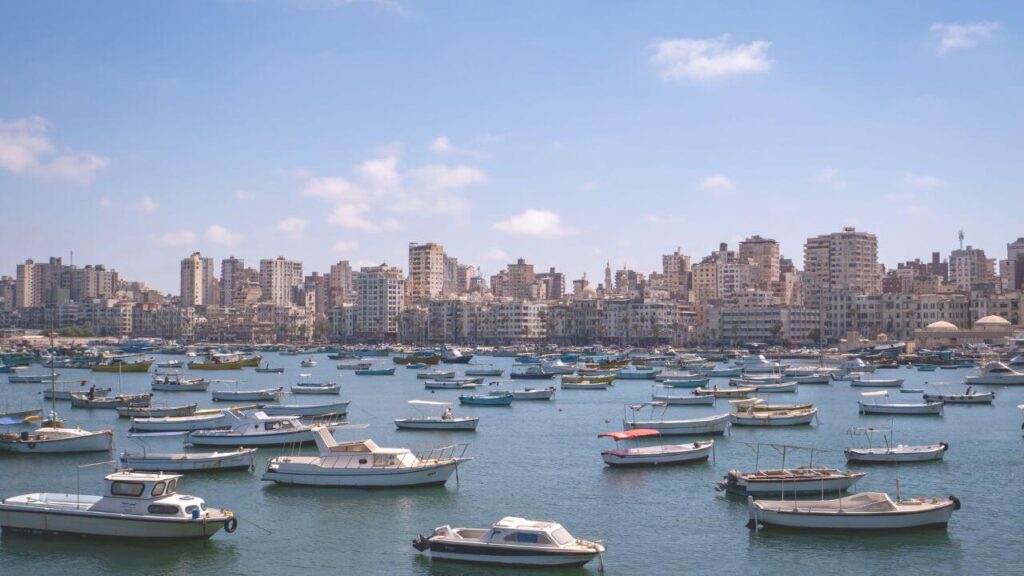
Summers (June to August) are hot and crowded but perfect for beachgoers. Winters are mild but with occasional rain.
We made a guide on which is The best time to visit Egypt.
Getting There and Around
Getting to Alexandria, Egypt, and navigating the city requires some planning. Here are the primary ways you can reach and get around Alexandria:
International Travel to Egypt and Domestic Travel to Alexandria:
Air Travel
- International: Most international travelers arrive in Egypt via Cairo International Airport (CAI), which is the busiest in the country and offers the most options.
- Domestic: From Cairo, you can catch a domestic flight to Alexandria’s Borg El Arab Airport (HBE), which is about 45 kilometers from the city center. The airport serves a number of domestic and regional flights.
Trains
- Egypt has a well-connected railway system, and traveling from Cairo to Alexandria by train is a popular option. The journey takes approximately 2 to 3.5 hours depending on the service (regular or express trains).
- The trains are relatively comfortable and offer first-class and second-class tickets.
Buses
- Several companies operate buses between Cairo and Alexandria. The journey can take about 3 hours, depending on traffic.
- Buses range from basic to luxury, with some offering amenities like air conditioning and onboard restrooms.
Transportation Options within Alexandria
Trams and Buses
Alexandria has a vast network of local buses and the oldest tram system in Africa. They’re the cheapest way to travel but can be very crowded.
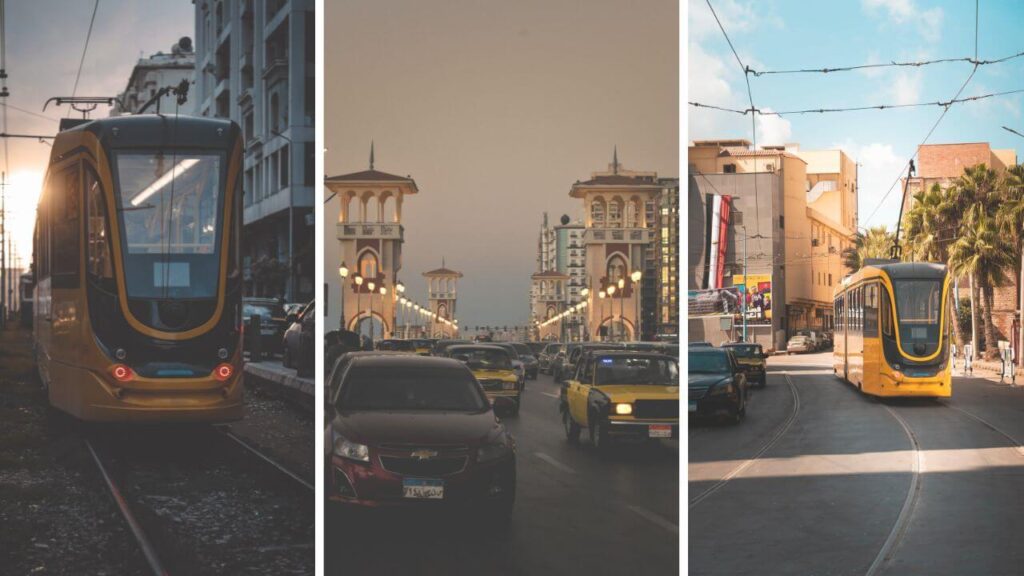
Taxis
Taxis are plentiful in Alexandria. It’s advisable to insist on using the meter to avoid overcharging. Ride-hailing apps like Uber and Careem are also available and offer a convenient way to get a ride with predetermined fares.
Car Rentals
Several car rental agencies operate in Alexandria. However, visitors should be prepared for heavy traffic and different driving habits.
Walking and Bicycles
Alexandria is a walkable city, especially along the Corniche and in the downtown area. However, cycling might not be the best option due to the city’s busy traffic and lack of bike lanes.
Understanding the various transportation options will help you efficiently plan your trip and ensure a more enjoyable stay in Alexandria. Always consider safety, comfort, and convenience when choosing your mode of transportation.
What to visit in Alexandria
When in Alexandria, a city imbued with history and coastal charm, there are several key sites and experiences not to be missed:
The Citadel of Qaitbay
The Citadel of Qaitbay is a picturesque Islamic fortress located on the coast of the Mediterranean Sea in Alexandria, Egypt. Established in 1477 AD by Sultan Al-Ashraf Sayf al-Din Qa’it Bay, the Citadel is situated on the eastern point of Pharos Island. On this exact site, one of the Seven Wonders of the Ancient World, the famed Lighthouse of Alexandria, once stood. This strategic position was chosen to protect the city from the threat of Crusader invasions.
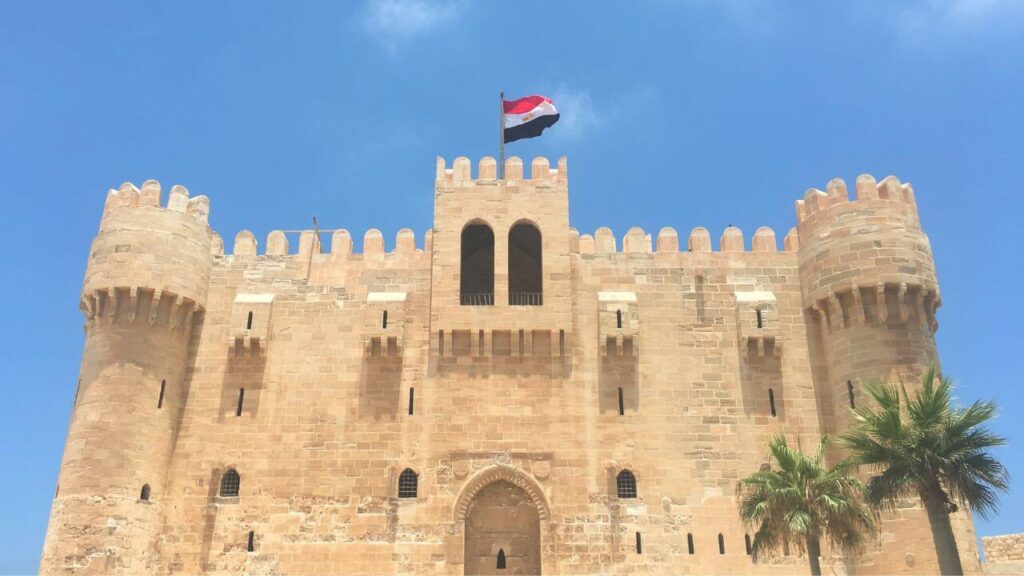
The Citadel is an exemplary display of military architecture during the Mamluk era. Its defensive significance diminished with the advancement of military technology, but its cultural and historical value only increased. Made primarily from the stones of the ruined Lighthouse, the Citadel is not just a connection to the medieval Islamic world but also an indirect link to ancient Greek history.
Today, the Citadel of Qaitbay serves as a symbolic monument and a museum open to the public, offering a glimpse into its rich history. Visitors can explore the maze of stone-walled rooms and enjoy panoramic views of Alexandria from its walls. The area surrounding the Citadel is lively, with the bustling activity of small fishing boats and the nearby aquarium adding to the local charm.
The Citadel of Qaitbay, with its robust and imposing structure, is not only a significant historical site but also a testament to the resilience and enduring legacy of Alexandria’s rich past. It is a must-see landmark for any traveler seeking to immerse themselves in the depth and diversity of Egyptian history.
Catacombs of Kom El Shoqafa
The Catacombs of Kom El Shoqafa, nestled in the heart of Alexandria, Egypt, are a profound testament to the city’s diverse cultural heritage. Discovered accidentally in the early 20th century, these subterranean burial chambers date back to the 2nd century AD, reflecting a unique blend of Egyptian, Greek, and Roman art and architecture, a fusion resulting from Alexandria’s position as a crucible of civilizations.
The catacombs, whose name translates to “Mound of Shards,” were originally a private tomb, eventually expanding to house the remains of numerous individuals. The site plunges three levels underground, though only the first level is open to the public. Here, visitors can explore a series of ancient passageways and antechambers adorned with various reliefs and statues that illustrate the era’s artistic fluidity and religious syncretism.
Of particular interest is the Triclinium, a banquet hall where families of the deceased would host commemorative feasts, and the Hall of Caracalla, a space allegedly dedicated to the tomb’s more recent victims. The catacombs’ design, featuring a spiral staircase descending around a central well, further highlights the blend of influences, marrying traditional Egyptian design elements with Roman-style rock-cut architecture.
Today, the Catacombs of Kom El Shoqafa stand as one of the most significant archaeological sites in Alexandria and are recognized as a UNESCO World Heritage site. They offer an unmissable journey for travelers, providing insight into the complex cultural tapestry and burial traditions of ancient Alexandria. This historical marvel, hidden beneath the city’s surface, invites visitors to step back in time and experience the multicultural legacy that still resonates within the modern metropolis.
Bibliotheca Alexandrina (Alexandria Library)
The Bibliotheca Alexandrina is not just a library but a vast cultural complex located on the Mediterranean shore in Alexandria, Egypt. It’s a commemoration of the ancient Library of Alexandria, seeking to emulate its spirit of learning and inclusivity.
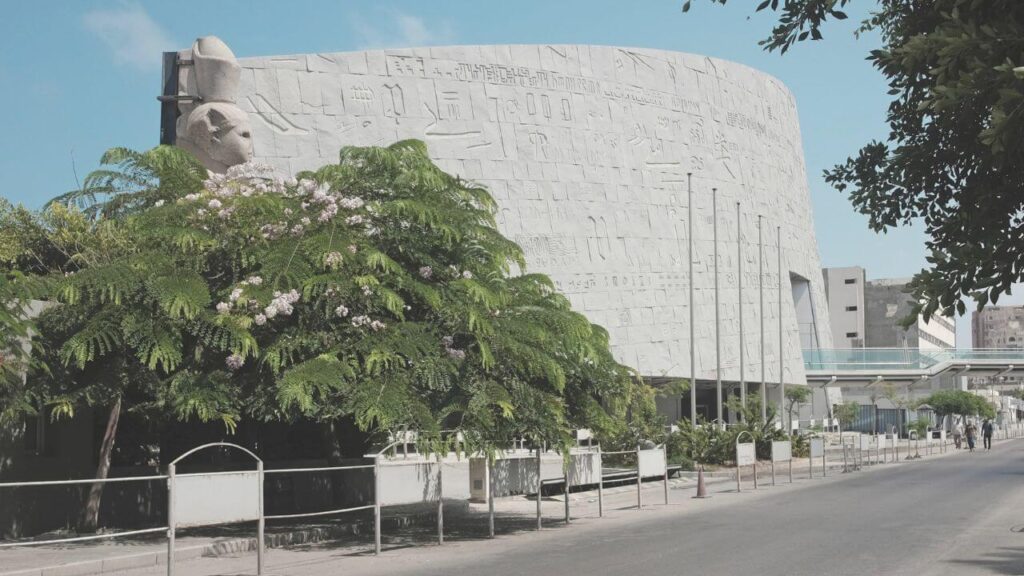
This modern marvel, inaugurated in 2002, is an architectural masterpiece featuring a giant sun-disc-shaped building symbolizing the Egyptian sun rising from the sea. The library’s walls are adorned with characters from every known alphabet, reflecting its universal approach.
Inside, visitors find much more than millions of books in multiple languages. The Bibliotheca Alexandrina houses several galleries, four museums, and a planetarium. Its collections range from the history of science and antiquities to personal belongings of Egypt’s last king, Farouk I. The library also hosts numerous events, exhibitions, and conferences throughout the year, contributing to global dialogue and cultural exchange.
The library’s dedication to digital preservation is noteworthy, with efforts like the digitization of rare manuscripts and the creation of an extensive electronic archive, making knowledge accessible worldwide.
For travelers, the Bibliotheca Alexandrina is a beacon of knowledge, offering insights into both the rich history and contemporary cultural landscape of Egypt. It’s not just a destination for book lovers, but for anyone intrigued by architecture, history, and the ongoing pursuit of knowledge. This iconic institution represents a bridge between the past and the future, making it a must-visit landmark in Alexandria.
Montazah Palace Gardens
The Montazah Palace Gardens, sprawling over 200 acres along the Mediterranean Sea in Alexandria, Egypt, are a stunning blend of history, architecture, and natural beauty. These gardens encircle the Montazah Palace, which was the summer residence of the former Egyptian royal family, built in 1892 by Khedive Abbas II.
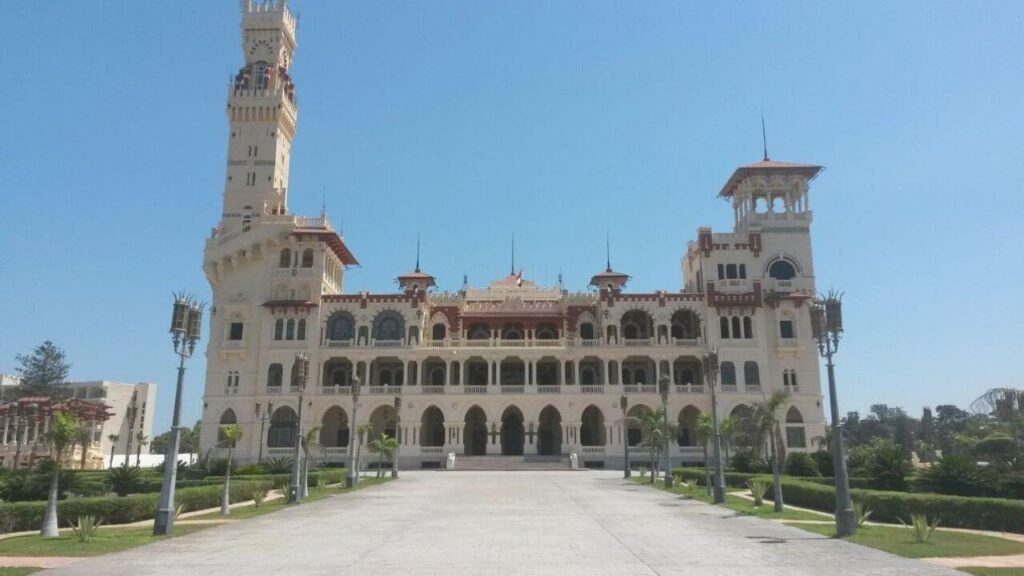
The palace itself, an architectural jewel, combines Florentine and Turkish styles, creating a visually striking structure. While the palace is not open to the public, the surrounding gardens are, offering visitors a serene escape with lush greenery, vibrant flowers, and towering palm trees.
Visitors can stroll along well-maintained paths, enjoy panoramic sea views, and discover charming bridges, old Florentine towers, and various smaller palaces scattered throughout the gardens, each with its unique style and history. The gardens are a popular spot for picnics, boat rides, and even swimming, with beaches located within the complex.
Montazah Palace Gardens are not just a display of natural and architectural beauty, but also a testament to Alexandria’s modern history, reflecting the opulence of its former royal era. It’s a perfect destination for those seeking a peaceful retreat, family-friendly activities, or a romantic walk by the sea, making it a must-visit spot for travelers in Alexandria.
Pompey’s Pillar
Pompey’s Pillar stands as a monumental relic of ancient history in the midst of modern Alexandria, Egypt. This impressive Roman triumphal column is a solitary remnant of the ancient and illustrious Serapeum, a temple dedicated to the god Serapis, which once showcased grandiosity and architectural prowess.
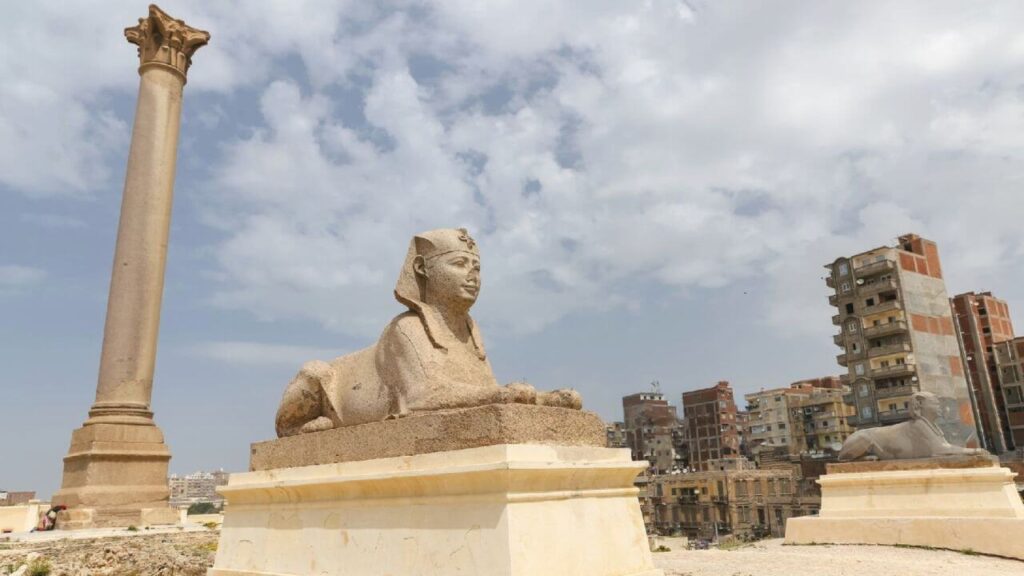
Misnamed for the Roman general Pompey, who was actually killed in Egypt following his defeat to Julius Caesar, the column was actually constructed in 297 AD to honor Emperor Diocletian. The monolithic column, made of red Aswan granite, stands approximately 28 meters high, and the shaft itself is a staggering 2.7 meters in diameter, making it the largest of its kind outside of the imperial capitals of Rome and Constantinople.
The site offers more than just the column; the surrounding ruins, including sphinx statues and remnants of the Serapeum, give visitors a sense of the grand scale of the original temple complex. Subterranean galleries beneath the ruins can also be explored, where remnants of the Daughter Library of Alexandria were believed to be housed.
Pompey’s Pillar serves as a tangible connection to the ancient world for travelers. It’s not just an historical site, but a marker of architectural progress, political change, and the rich tapestry of cultures that intermingled in ancient Alexandria. This landmark is a must-visit for those who seek to understand the depth and resilience of Egyptian history, standing tall as a testament to the city’s ever-evolving narrative.
Alexandria Opera House
The Alexandria Opera House, known as the Sayed Darwish Theatre, is a bastion of cultural sophistication and artistic expression in the heart of Alexandria, Egypt. Named after the iconic composer Sayed Darwish, the Opera House is a hub for the performing arts in a city that has long been considered the cultural capital of the country.
This historic venue, inaugurated in 1921, boasts a stunning blend of neo-classical and Renaissance architecture, making it a visual delight even before visitors step inside to experience its acoustic wonders. The façade, adorned with intricate designs and majestic columns, speaks to the artistic marvels that lie within.
Inside, the Alexandria Opera House has a rich program that caters to all tastes, featuring an array of performances ranging from classical opera to contemporary music concerts, ballet, and traditional Egyptian performances. The theatre is renowned for its superb acoustics and intimate setting, ensuring that every attendee has an immersive experience.
The Opera House is more than a venue; it’s a vibrant cultural institution that fosters artistic creativity, celebrates Egypt’s musical heritage, and provides a platform for international artists. For travelers, attending a performance here isn’t just an evening’s entertainment; it’s an opportunity to engage with Egypt’s rich cultural tapestry and witness the continuation of Alexandria’s storied artistic legacy. The Alexandria Opera House is a must-visit for any art enthusiast exploring the depths of Egypt’s cultural scene.
Serapeum of Alexandria
The Serapeum of Alexandria, once an imposing temple dedicated to the Greco-Egyptian god Serapis, stands as a significant archaeological site, offering visitors a glimpse into the religious and cultural milieu of ancient Alexandria, Egypt. It’s built in the 3rd century BC, the Serapeum served as both a religious complex and a symbol of the confluence of Greek and Egyptian cultures.
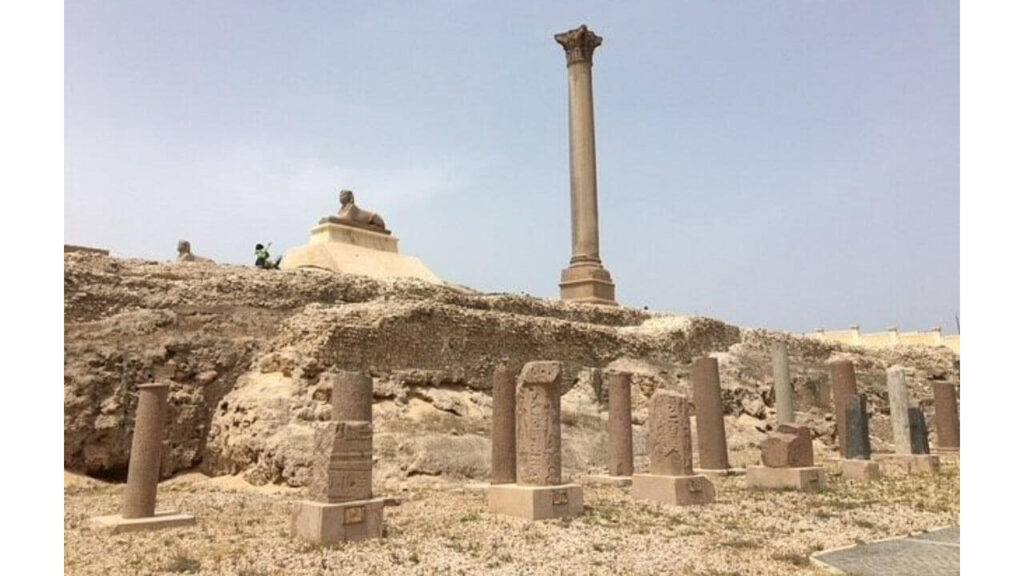
Photo source: Tripadvisor.com
While the temple was unfortunately destroyed in 391 AD during a Christian uprising, the remnants of the Serapeum still possess an aura of its past grandeur and significance. The site is most famously home to Pompey’s Pillar, an erroneously named monolithic column that is one of the largest constructed outside the imperial cities of Rome and Constantinople. Standing about 28 meters tall, this red Aswan granite column was dedicated to Emperor Diocletian in the 4th century AD.
Visitors can also explore the underground galleries beneath the ruins, believed to have housed part of the Daughter Library of Alexandria. These passages offer a fascinating insight into the architectural practices of ancient times and the extensive scope of the Serapeum’s original layout.
Travelers to this site embark on a journey through time, exploring the depths of ancient beliefs and the ever-evolving tapestry of human civilization. It’s a must-visit landmark for those seeking to understand the multifaceted layers of Alexandria’s ancient history.
Ancient Roman Theatre
The Roman Amphitheatre of Alexandria, discovered in 1960, is a unique window into the city’s Roman past, dating back to the 2nd century AD. This well-preserved theatre, the only known Roman amphitheater in Egypt, once seated up to 800 spectators, highlighting its historical importance for social gatherings and performances.
Notable for its white marble seats and advanced acoustic design, the theatre showcases the architectural ingenuity of the era. Visitors can also explore the underground galleries, thought to be waiting or storage areas, and nearby ruins of baths and lecture halls within the archaeological park.
The site is more than an ancient relic; it’s a cultural landmark where travelers can immerse themselves in the leisure and artistic atmosphere of ancient Roman Alexandria. Its distinctive blend of history and architecture makes it a must-visit for those exploring Alexandria’s rich heritage.
Beaches in Alexandria to visit
Alexandria, famed for its Mediterranean charm, offers travelers picturesque beaches perfect for relaxation and recreation.
Maamoura Beach
Nestled in an upscale neighborhood, Maamoura Beach is known for its clean sand and calm waters, making it ideal for families. The beach is part of a larger complex with hotels and restaurants, providing visitors with numerous amenities. Its quieter nature makes it perfect for those seeking a more peaceful beach experience.
Montazah Beach
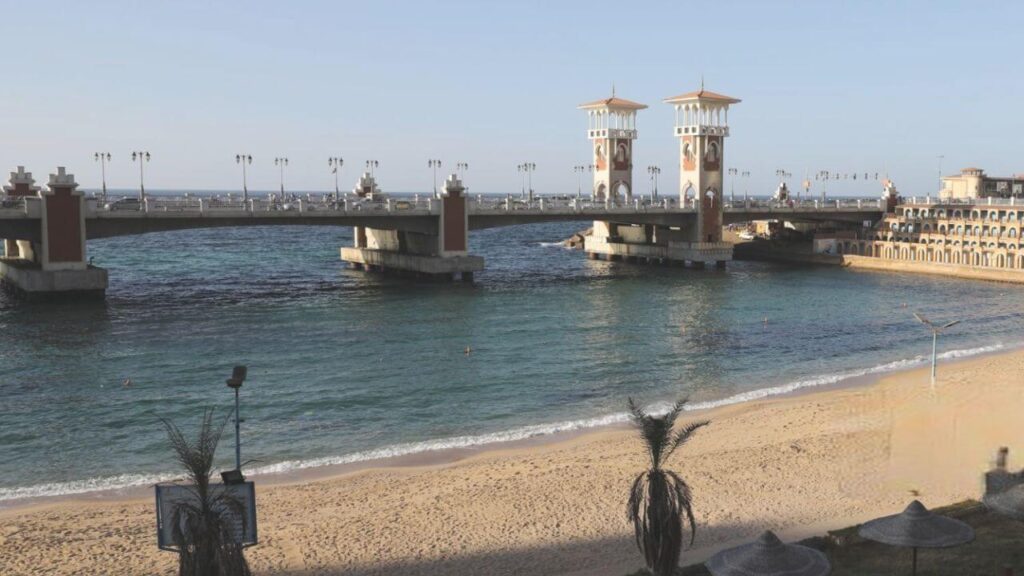
Located within the royal gardens of the Montazah Palace, this beach combines natural beauty with historical allure. Its clear waters are suitable for swimming, and the surrounding lush gardens provide a unique backdrop for sunbathing. The proximity to the palace also offers visitors an opportunity to explore the area’s rich history.
Alexandria Corniche
Stretching along the waterfront for over 10 miles, the Corniche is not just a beach but an experience. It’s lined with eateries, cafes, and shops, making it a vibrant hub of activity. The beach offers stunning views of the Mediterranean, and the bustling promenade is perfect for evening strolls. While swimming here might not be as common due to the urban setting, the Corniche is integral to experiencing the heart of Alexandria.
Each of these beaches offers a unique blend of the Mediterranean’s scenic beauty and Alexandria’s distinctive cultural touchpoints, making them must-visit destinations for any traveler to this historic city.
What to eat in Alexandria
Alexandria, with its rich history and coastal location, offers a unique culinary journey characterized by a fusion of cultures and flavors. Here’s what you should savor in the city:
Traditional Alexandrian Cuisine
Ful and Ta’meya (Fava Beans and Falafel): A staple in Egyptian cuisine, Alexandria offers its unique spin on these dishes, often served with an array of pickles, salads, and bread.
Koshary: This traditional Egyptian dish combines rice, macaroni, lentils, chickpeas, fried onions, and is typically topped with tomato sauce and a garlic vinegar dressing. It’s a must-try comfort food available almost everywhere.

Feseekh: A local delicacy, Feseekh is fermented, salted fish traditionally eaten during the Sham el-Nessim festival marking the arrival of spring. It’s an acquired taste but a deep dive into local culinary traditions.
Unique Food Experiences
Seafood by the Mediterranean: Given its coastal location, Alexandria boasts a variety of fresh seafood. Local eateries and upscale restaurants alike serve fish, shrimp, calamari, and more, often caught the same day and cooked to your liking. Enjoying seafood while overlooking the Mediterranean is a quintessential Alexandrian experience.
Alexandrian Sweets: Desserts in Alexandria deserve special mention, particularly the local ice cream at Azza and the traditional desserts like “basbousa” and “kunafa” available in local patisseries.

Café Culture: Sipping coffee at one of the city’s historic cafes, such as the famous Delices or Athineos, offers not just a taste of strong Egyptian coffee or tea, but also a glimpse into the local way of life, often with a view of the Mediterranean.
Dining in Alexandria is not just about the flavors, but also the atmosphere — the hustle and bustle of the markets, the gentle sea breeze at the waterfront eateries, and the blend of the traditional with the cosmopolitan in this historic city. Whether you’re enjoying street food or sitting in a fine-dining restaurant, Alexandria’s food scene is sure to captivate your taste buds.
Where to sleep in Alexandria
Accommodation in Alexandria, Egypt, caters to a range of preferences and budgets, offering a mix of historic elegance, modern comfort, and affordable lodgings.
Luxury Hotels
For those seeking a lavish stay, properties like the Four Seasons Hotel Alexandria at San Stefano or the historic Cecil Hotel offer top-tier comfort with stunning Mediterranean views. These hotels provide luxurious rooms, fine dining, excellent services, and easy access to major tourist attractions.
Mid-range Hotels
Travelers looking for a comfortable stay without an extravagant price tag might consider options like Cherry Maryski Hotel or Plaza Hotel Alexandria. These establishments offer decent amenities, good locations, and often include sea views or proximity to the beach.
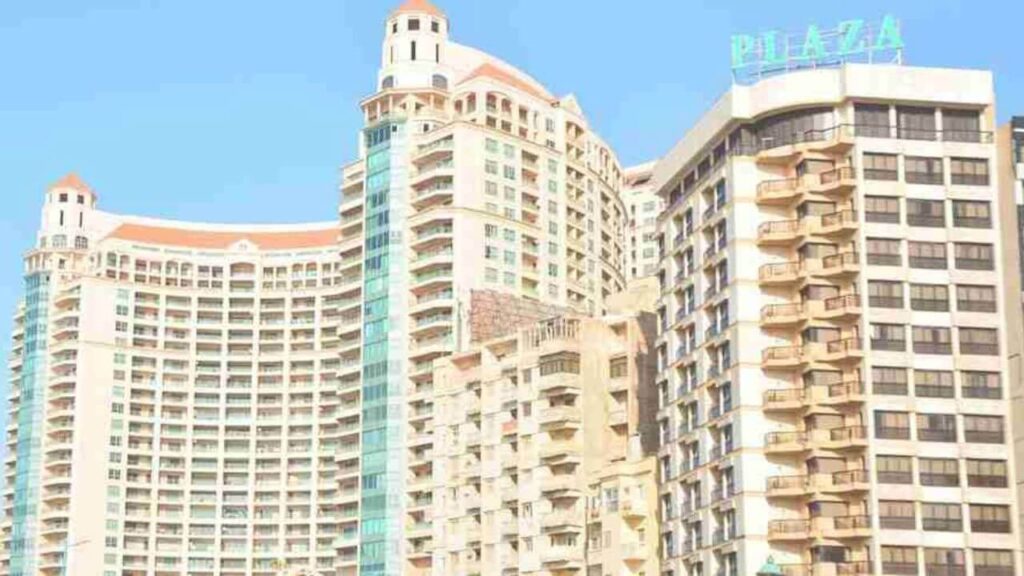
Photo Source: Booking.com
Budget Accommodations
Budget-conscious travelers can find affordable yet comfortable lodgings in hostels or guesthouses like the Alexander the Great Hotel-Alexotel. These options often provide basic amenities, clean rooms, and a friendly atmosphere, allowing for a cost-effective stay.
Apartments and Rentals
For more extended stays or a home-like experience, visitors might opt for serviced apartments or vacation rentals available through platforms like Airbnb. These are especially suitable for families or groups and often offer the flexibility of self-catering.
Historical Properties
For a unique experience, some choose accommodations in converted historic buildings, offering a distinctive atmosphere imbued with Alexandria’s rich past.
When choosing accommodation, consider proximity to attractions, beach access, city views, and local transportation options. Regardless of your budget, Alexandria offers a variety of accommodations, ensuring a pleasant stay in this historically rich coastal city.
Shopping and Local Crafts
Shopping in Alexandria combines traditional bazaars, local crafts, and modern retail experiences.
El Attarine Souk
This vibrant market in the city’s heart is a treasure trove of antiques, vintage items, and traditional crafts. Here, you can find everything from old books and jewelry to brassware and intricate textiles. The souk is a maze of narrow alleys, filled with the allure of the past and the buzz of haggling – a cultural experience as much as a shopping destination.

Local Crafts and Souvenirs
Alexandria’s rich history is reflected in its local crafts. Traditional items like pottery, glassware, and leather goods make for unique souvenirs. Don’t miss the locally made perfumes and essential oils, especially the jasmine, for which the city is famous. For a truly local experience, consider purchasing handmade rugs or tapestries that depict Egypt’s rich heritage.
Modern Shopping – Malls and Boutiques
For a more contemporary shopping experience, Alexandria houses several malls offering a range of international and local brands. City Centre Alexandria and San Stefano Grand Plaza are popular destinations for high-end shopping and entertainment. Boutiques scattered around the city, especially in neighborhoods like Zamalek, offer exclusive fashion, accessories, and artisanal products showcasing modern Egyptian creativity and style.
In Alexandria, shopping spans the spectrum from the historic and traditional to the sleek and contemporary, providing visitors with a diverse range of options. Remember to haggle in the markets and souks, as it’s part of the local shopping culture!
Events and Festivals in Alexandria
Alexandria’s cultural scene is a vibrant tapestry, and its events and festivals reflect the city’s rich heritage and contemporary artistic energy.
International Film Festival of Alexandria
The International Film Festival of Alexandria is a prestigious event is one of Egypt’s oldest film festivals, celebrating both regional and international cinema. Travelers can enjoy a diverse array of films, including features, documentaries, and shorts, often with English subtitles.

The festival fosters cultural exchange and artistic expression, making it a must-attend for cinephiles visiting the city. It typically takes place in autumn, so plan accordingly if you wish to attend.
Alexandria Mediterranean Countries Festival
This festival celebrates the cultural diversity of the Mediterranean region, showcasing an eclectic mix of music, dance, and theater performances from countries that border this sea.
It’s an excellent opportunity for travelers to witness the artistic vibrancy of the Mediterranean without leaving Alexandria. The festival usually features free and ticketed events in September or October.
Other Cultural and Seasonal Events
Alexandria Book Fair
A paradise for bibliophiles, this event usually takes place in the summer, offering a vast range of books and literary sessions, often focusing on Middle Eastern authors.
Summer Concert Series
During the summer months, various venues across the city host musical performances ranging from traditional Egyptian to contemporary world music.

Sham el-Nessim
A traditional Egyptian holiday marking the beginning of spring, usually in April. The city comes alive with festivities and special foods like “feseekh” (fermented fish) are enjoyed.
Christmas and New Year Celebrations
Given its cosmopolitan history, Alexandria hosts vibrant celebrations during the festive season, especially in areas like the Quartier des Consuls.
These events are entertainment and a pathway into the heart of Alexandria’s diverse cultural and artistic life. They provide a unique opportunity to engage with the local community and immerse oneself in the city’s rich traditions and contemporary expressions.
Travel Tips
Traveling to Alexandria can be a delightful experience, and knowing some insider tips can make your journey even more enjoyable. Here’s what you need to know:
Local Customs and Etiquette
Dress modestly, especially when visiting religious sites. Women should carry a scarf to cover their heads in mosques.
Public displays of affection are not widely accepted, especially near religious or cultural sites.
Tipping, locally known as “baksheesh,” is customary in Egypt. Small tips are expected for many services, from restaurants to restroom attendants.
Respect bargaining as part of the culture when shopping in local markets, but do so politely.
Additional Tips
- Stay hydrated, especially in the summer, and always carry bottled water.
- Learn a few basic phrases in Arabic; it can help in navigating the city and is appreciated by locals.
- Keep your belongings secure and be mindful of pickpockets in crowded areas like markets or tourist sites.
- Having some cash besides credit/debit cards is recommended, as many smaller shops or eateries may not accept cards.
- For any health concerns, stick to reputable clinics and hospitals. Pharmacies are generally well-stocked, and pharmacists often speak English.
Remember, flexibility and patience are key to enjoying the dynamic culture and rhythm of life in Alexandria. This historic city has much to offer, and these tips should help ensure a smooth, enjoyable experience.
Budgeting Your Trip
General Cost of Traveling in Alexandria
- Alexandria, like many cities in Egypt, can be quite affordable for travelers. Accommodations, eating out, and transportation are generally reasonably priced.
- Hotel prices can range significantly, from budget lodgings at around EGP 200-400 per night to luxury accommodations that can exceed EGP 1,500.
- Meals at inexpensive restaurants may cost around EGP 50-100 per person, while a three-course meal at a mid-range restaurant can range from EGP 200-350.
- Entrance fees for various attractions are relatively modest, often under EGP 100.
Tips for Budget Travel
- Public transportation, like trams and buses, is an inexpensive way to travel around the city, though they can be crowded.
- Street food is not only a great way to experience local flavors but is also very budget-friendly.
- Take advantage of the numerous free attractions, like walking along the Corniche or visiting public beaches.
- If possible, travel during the shoulder seasons (spring and autumn) to avoid the summer crowds and enjoy potentially lower prices on accommodations.
- For sightseeing, consider purchasing a tourist pass if available, as it might offer cost-saving benefits.
Currency Exchange and Transaction Tips
- The currency used is the Egyptian Pound (EGP). While credit and debit cards are accepted in many places, cash is often preferred, especially in smaller shops and when dealing with street vendors.
- ATMs are widely available throughout Alexandria, but it’s advisable to use machines inside banks, hotels, or malls for better security.
- Currency exchange services are available at airport, banks, and exchange bureaus. However, banks or ATMs often offer the best exchange rates.
- Be cautious of hidden fees when using credit cards or exchanging money; always ask ahead about commission rates.
- Tipping (baksheesh) is a common practice, and small tips are expected for many services.

Budgeting wisely and being aware of the general costs can greatly enhance your travel experience in Alexandria. Keeping cash on hand, being mindful of where you exchange currency, and using local transportation can save you money and immerse you more deeply in local life.
Final Words
Visiting Alexandria is like stepping into the pages of history while still firmly rooted in the vibrancy of modern life. This city, with its compelling blend of history, culture, and Mediterranean charm, offers an unforgettable journey for any traveler.
Whether you find yourself haggling in the lively souks, soaking in the diverse artistic expressions at local festivals, or simply gazing out at the endless blue of the Mediterranean, Alexandria invites you to lose yourself in its magic.
Don’t just come to Alexandria to see the sights; experience a tapestry of cultures, witness the dialogue between the ancient and the contemporary, and create your own stories. Each corner of this city holds a new discovery; each street, a lesson in history and humanity.
As you conclude your visit, you’ll carry with you not just photographs or souvenirs but a piece of Alexandria’s timeless essence. This experience lingers long after you’ve bid its shores farewell. So, when you visit, come with an open heart and a curious spirit because Alexandria isn’t just a destination—it’s an ongoing narrative that invites you to be a part of its story.

